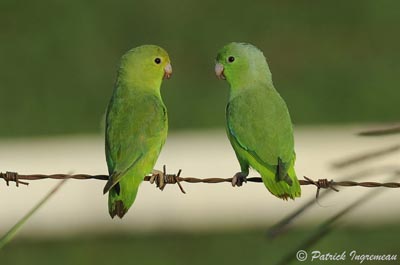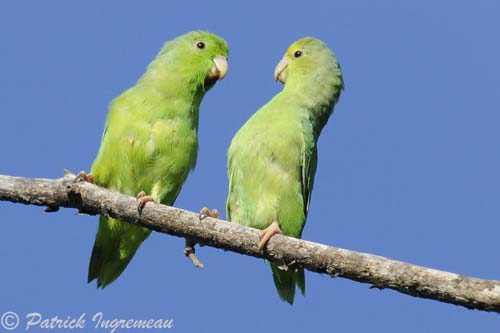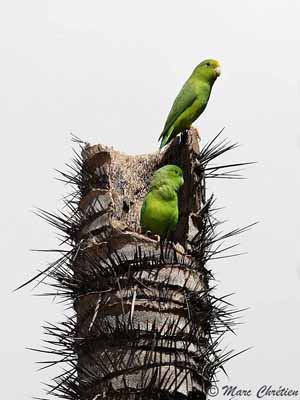
Green-rumped Parrotlet
Forpus passerinus
Psittaciforme Order - Psittacidae Family
BIOMETRICS:
Length : 12-13 cm ; Weight : 20-28 g
LONGEVITY: About 25 years
DESCRIPTION:
The Green-rumped Parrotlet is a very small parrot, the smallest of the Americas.
The adult male has green plumage overall, slightly paler on the underparts.
On the upperparts, back and rump are deep green. The rump may be brighter, but also tinged blue.
On the wings, the primary coverts are dark blue, and the secondaries are rather blue, whereas the greater coverts are pale blue. The tail is short and green.
On the underwing, the coverts are dark blue.
On the green head, forehead and cheeks are paler than the crown. The nape is rather green with greyish tinge.
The hooked bill is pinkish-horn. Eyes are brown with greyish white eye-ring. Legs and feet are pinkish brown.
The adult female is very similar, but she lacks the blue feathers on the wings. She has green plumage overall, with paler yellowish green underparts, and tinged yellow forehead and ocular area.
The immature resembles adults.

The Green-rumped Parrotlet has several subspecies, which differ in plumage colour, with mainly green plumage overall, but with some variations on the blue wing feathers, and more or less pale underparts.
VOICE: SOUNDS BY XENO-CANTO
The Green-rumped Parrotlet utters loud chattering when it forages in flocks. In flight, it gives shrill notes such as “cheet it” or “chee-sup” repeated several times.
When threatened, it gives deep “tsup…tsup”.
HABITAT:
The Green-rumped Parrotlet lives mainly in open and semi-open lowlands areas, dry forest edges, scrublands, gallery forests along streams, cultivated areas with some trees and shrubs. It may be found in parks and gardens, and sometimes in more humid areas such as mangroves. It may be seen up to 1800 metres of elevation.
RANGE:
The Green-rumped Parrotlet lives in northern South America, in tropical areas. It breeds from Colombia, Venezuela and Trinidad, to Guianas and Brazil.
This species has been introduced in several Caribbean islands, but in Martinique, the introduction failed.
BEHAVIOUR:
The Green-rumped Parrotlet feeds mainly on seeds from several grasses’ species. It gets the seeds by perching on the grass stem. The weight of the bird bends the seed heads towards the ground, making them easier to take. It also feeds on berries and fruits, buds, blossoms and seeds of the sunflower.
The Green-rumped Parrotlet is resident in its range, only performing some movements for food, or seasonal and altitudinal movements.
This bird is usually seen in flocks outside the breeding season. During the reproduction, they are often seen alone or in pairs.
They feed among foliage and grasses, calling incessantly. They are noisy when flying in flocks.
This species in very gregarious and the birds gather at communal roost at night.
FLIGHT:
The Green-rumped Parrotlet performs undulating flight, with rapid wing beats interspersed with closed wings.

DIET:
The Green-rumped Parrotlet feeds mainly on seeds from grass and weeds, small berries and fruits. It also consumes leaf buds and blossoms.
PROTECTION / THREATS / STATUS:
The Green-rumped Parrotlet is usually common in its range. The populations are increasing, and benefit from deforestation within their habitat.
This species suffers heavy pet-trade in Venezuela. However, this parrotlet is not threatened at this moment.
All : Grünbürzel-Sperlingspapagei
Esp: Cotorrita Culiverde
Ital: Pappagalletto groppone verde
Nd: Groene Muspapegaai
Photographs by Patrick Ingremeau
His website : TAMANDUA
Photograph at nest by Marc Chrétien
His website :
MURINUS
Text by Nicole Bouglouan
Sources :
HANDBOOK OF THE BIRDS OF THE WORLD volume 4 by Josep del Hoyo, Andrew Elliot and Jordi Sargatal – LYNX EDICION – ISBN 8487334229
PARROTS OF THE WORLD – An Identification Guide – by Joseph M. Forshaw – Princeton University Press – ISBN 0691092516
A GUIDE TO THE BIRDS OF COLOMBIA by Steven L. Hilty and William L. Brown
Princeton University Press – ISBN 069108372X
Wikipedia (Wikipedia, The Free Encyclopedia)
